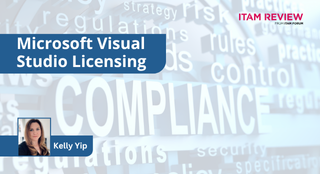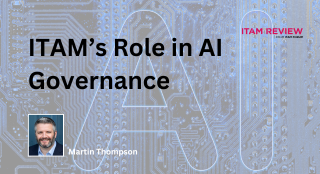What ITAM can learn from contract management: Lessons from Schiphol Airport
What can ITAM learn from contract management?
ITAM Arjen Hamerling is IT Contract Manager at Schiphol Group, the owner and operator of Amsterdam Airport Schiphol. Arjen is responsible for both Software Asset Management and Contract Management for all publisher contracts within Schiphol IT, including the likes of Microsoft, Oracle, IBM, Citrix, Red Hat, and VMware.

As an international airport that processed over 48 million passengers last year, a good proportion of the hardware and software managed by Schiphol IT is used to optimise the flow of people through the airport. From their initial arrival through to check-in, security, boarding and departure, a passenger’s every step is seamlessly monitored, managed and optimised by IT. And with the sheer amount of logistical, safety and security measures that operating an airport entails, there really is no room for errors when it comes to Schiphol’s IT.
Initially responsible for SAM, Arjen’s role has since expanded to include Contract Management, where he has found himself asking far more fundamental questions about the value of software to the business.
We spent some time with Arjen earlier this year to explore some of the lessons he has learned since moving into his contract management role, and what SAM/ITAM professionals can do to unlock the most value from the software they manage.
Defining the true value of software
When Arjen moved from SAM/ITAM into contract management he was faced with a question he had never tackled before: How does your software contribute to the company’s goals? “I hadn’t asked this question before. So I needed to interview stakeholders to understand what the software is actually used for so that I could understand its value.”
“For example, one of the pieces of software I was investigating seemed really expensive to me, so I was looking at ways we could reduce our expenditure. But one meeting with a stakeholder changed my perspective – they pointed out that just 30 minutes without this software would cost the airport the same as 3 years’ of its licence. When seen from that perspective this software is very good value.”
Stuck in the middle with you
Arjen believes that contract management is the closest you can get to the centre of understanding the true value of software due to the questions it forced you to ask. “When I worked in SAM I felt I was in the middle of everything when it came to understanding and managing software value, but now, as the contract manager, I find myself more in the middle than ever before. In SAM we were always one step removed. We knew what software cost in monetary terms, but we didn’t know what it was truly worth to the company.”
At the end of the day, it is not enough to get the best price for the software, you need to know that it delivers value to the company. You can bring all sorts of software into the company, but what do you actually know as an ITAM/SAM manager about its value?
Arjen describes this shift in perspective as the shift from information to wisdom. “In ITAM we are often stuck at the information stage – we need to go up the Knowledge pyramid to the knowledge and wisdom stages. It’s about elevating our view.”
What advice would you have for your SAM colleagues?
Ask more fundamental questions about value
“SAM needs to reach out to the company more in order to understand the true value of software to the organisation. You need to speak to the contract owners to make informed decisions about the software you are managing. Counting alone won’t tell you enough – you need to understand why something is why it is before you can make a decision on it. What are the future plans for it, are there seasonal requirements for example? Just because usage appears to be low now doesn’t necessarily mean the software can be scaled back. There may be other factors that you’re unaware of.”
This is not to say there aren’t still significant savings to be made from bloated software. It’s about determining which is bloated and which is fit-for-purpose. “For example, we had a Citrix cluster that was severely underutilised. 192 processors running for only 300 employees with processor utilisation as low as 4% at times. Scaling this back saved us €200,000/year.”
Track the right data, not all the data
You don’t need to track all of the data. You can count cores all you want but if your contract is based on users what’s the point? Start with the contract first to determine which metrics to measure. Arjen says that it is possible to take data analysis too far that you end up analysing everything. “You have to draw the line somewhere and make a decision. Measuring everything is overkill and not necessary. I’m focusing on major savings. If it takes me more time to get the data than the potential saving available then there’s no point in doing it. This ensures I focus on the data that will deliver the highest value to the business.”
Keep on top of Oracle Java!
Oracle’s switch to user licensing for Java has had a big impact on Schiphol’s budget. “We have over 25,000 employees, so that’s a lot of Java licenses. On the one hand it has made the SAM process much easier for us, since counting employees is a much easier SAM process, but the problem is the high price per license. The change to employee licensing has tripled the cost of Java for us.”
Can’t find what you’re looking for?
More from ITAM News & Analysis
-
Broadcom vs Siemens AG - A Brewing Storm
The ongoing legal battle between VMware (under Broadcom ownership) and Siemens is yet another example of why ITAM goes far beyond license compliance and SAM. What might, at first glance, appear to be a licensing dispute, ... -
Shifting Left Together: Embedding ITAM into FinOps Culture
During one of the keynotes at the FinOps X conference in San Diego, JR Storment, Executive Director of the FinOps Foundation, interviewed a senior executive from Salesforce. They discussed the idea of combining the roles of ... -
Addressing the SaaS Data Gap in FinOps FOCUS 2.1
I recently reported on the FinOps Foundation’s inclusion of SaaS and Datacenter in its expanded Cloud+ scope. At that time, I highlighted concerns about getting the myriad SaaS companies to supply FOCUS-compliant billing data. A couple ...
Podcast
ITAM training
Similar Posts
-
Microsoft Visual Studio Licensing Guide: Reduce Risks
(This article was reviewed and updated on 3 July 2025) Visual Studio Licensing Visual Studio subscriptions are licensed Per User with each licensed user able to. “install and use the software on any number of device”. ... -
Microsoft Power Apps: Current Pricing Models Comparison
Back in November 2021, Microsoft made Power Apps available under the pay-as-you-go (PAYG) model, alongside the traditional Per User/Per App options. This PAYG model has gained popularity. It ensures simple rightsizing for Power Apps environments. Here, ... -
The M&S Cyberattack: How IT Asset Management Can Make or Break Your Recovery
Marks & Spencer (M&S), the iconic UK retailer, recently became the latest high-profile victim of a devastating cyberattack. Fellow retailers The Co-Op and Harrods were also attacked. Recent reports suggest the rapid action at the Co-Op ... -
AI in ITAM: Insightful Signals from the Front Line
During our Wisdom Unplugged USA event in New York in March 2025, we engaged ITAM professionals with three targeted polling questions to uncover their current thinking on Artificial Intelligence—what concerns them, where they see opportunity, and ...




